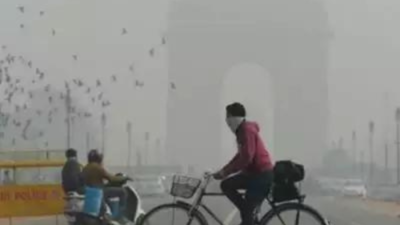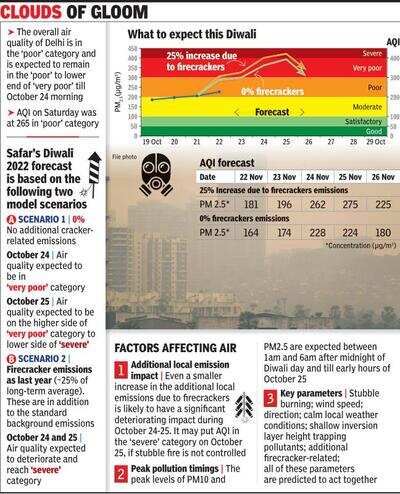Top Searches
- News
- City News
- delhi News
- Festive daze: AQI in Delhi may turn severe a day after Diwali
Festive daze: AQI in Delhi may turn severe a day after Diwali
NEW DELHI: Brace for a polluted Diwali again this year, especially if the ban on firecrackers proves ineffective. If there are no fireworks on Diwali, the air quality may be in the higher-end of the ‘very poor’ category or lower-end of ‘severe’ category a day later on October 25.
However, even if just a quarter of the firecrackers burst last year mark this year’s Diwali, the air is likely to deteriorate to ‘severe’ category on October 24 and 25.

This analysis by the Union earth sciences ministry’s forecasting setup, System of Air Quality and Weather Forecasting and Research (SAFAR), is based on two scenarios: if there is zero firecracker emission and if there is a 25% load of the average firecracker emissions in the past decade. “Under a zero-firecracker emission scenario, the level of PM2.5 is predicted to be in the ‘very poor’ category on Diwali (October 24). However, with adverse weather conditions bringing firecracker pollutants from surrounding regions to Delhi, one can expect a 15-18% stubble contribution without counting the Delhi load firecracker emissions. In such circumstances, AQI may touch the upper-end of ‘very poor’ or lower-end of ‘severe’ on October 25,” said SAFAR.
SAFAR added, “If an additional firecracker load of 25% of long-term cracker load is added alongside background emissions, AQI may worsen to ‘severe’ on October 24 and 25. This is mainly due to stable/inversion conditions during early morning hours that traps pollutants close to the surface.”
Track the pollution level in your city
It’s prediction is that air quality will improve slightly on October 26 with AQI at the lower end of ‘very poor’ because of surface winds picking up and stubble transport winds slow down.
Gufran Beig, founder project director, SAFAR, and chair professor at the National Institute of Advanced Studies, IISc, said, “Even a small increase in the additional local emissions due to firecrackers is likely to have a significant deterioration impact on the air on October 24 and 25. If rice stubble harvest fires are not controlled, the firecracker emissions may put AQI in the severe category on October 25. If the stubble fire count is brought under 100, AQI is likely only to remain in the ‘very poor’ level on October 25 without touching the ‘severe’ mark.”
If stubble burning increases gradually, which is likely, its share in Delhi’s PM2.5 level (based on the average temporal variability of fire counts in the previous years) is likely to be 5% on October 23, 8% on October 24 and 16-18% on October 25, said SAFAR.
Meanwhile, a haze appeared over the city on Saturday morning. Farm fires in the neighbouring states rose as Punjab, Haryana and Uttar Pradesh recorded 582, 122 and 18 paddy residue burning events, respectively, on Saturday. With these three states reporting a total of 722 stubble burning counts, this was the highest single day fire count recorded this season. However, the contribution of stubble burning to Delhi’s air pollutants was 3% due to an unfavourable wind direction.
The overall Air Quality Index (AQI) was recorded at 265 in ‘poor’ category on Saturday and it is predicted to remain in ‘poor’ to lower-end of ‘very poor’ category till October 24 morning. VK Soni, head, environment and research centre, India Meteorological Department (IMD), said, “Calm wind conditions during evening and night hours are trapping pollutants.”
However, even if just a quarter of the firecrackers burst last year mark this year’s Diwali, the air is likely to deteriorate to ‘severe’ category on October 24 and 25.

This analysis by the Union earth sciences ministry’s forecasting setup, System of Air Quality and Weather Forecasting and Research (SAFAR), is based on two scenarios: if there is zero firecracker emission and if there is a 25% load of the average firecracker emissions in the past decade. “Under a zero-firecracker emission scenario, the level of PM2.5 is predicted to be in the ‘very poor’ category on Diwali (October 24). However, with adverse weather conditions bringing firecracker pollutants from surrounding regions to Delhi, one can expect a 15-18% stubble contribution without counting the Delhi load firecracker emissions. In such circumstances, AQI may touch the upper-end of ‘very poor’ or lower-end of ‘severe’ on October 25,” said SAFAR.
SAFAR added, “If an additional firecracker load of 25% of long-term cracker load is added alongside background emissions, AQI may worsen to ‘severe’ on October 24 and 25. This is mainly due to stable/inversion conditions during early morning hours that traps pollutants close to the surface.”
Track the pollution level in your city
It’s prediction is that air quality will improve slightly on October 26 with AQI at the lower end of ‘very poor’ because of surface winds picking up and stubble transport winds slow down.
Gufran Beig, founder project director, SAFAR, and chair professor at the National Institute of Advanced Studies, IISc, said, “Even a small increase in the additional local emissions due to firecrackers is likely to have a significant deterioration impact on the air on October 24 and 25. If rice stubble harvest fires are not controlled, the firecracker emissions may put AQI in the severe category on October 25. If the stubble fire count is brought under 100, AQI is likely only to remain in the ‘very poor’ level on October 25 without touching the ‘severe’ mark.”
If stubble burning increases gradually, which is likely, its share in Delhi’s PM2.5 level (based on the average temporal variability of fire counts in the previous years) is likely to be 5% on October 23, 8% on October 24 and 16-18% on October 25, said SAFAR.
Meanwhile, a haze appeared over the city on Saturday morning. Farm fires in the neighbouring states rose as Punjab, Haryana and Uttar Pradesh recorded 582, 122 and 18 paddy residue burning events, respectively, on Saturday. With these three states reporting a total of 722 stubble burning counts, this was the highest single day fire count recorded this season. However, the contribution of stubble burning to Delhi’s air pollutants was 3% due to an unfavourable wind direction.
The overall Air Quality Index (AQI) was recorded at 265 in ‘poor’ category on Saturday and it is predicted to remain in ‘poor’ to lower-end of ‘very poor’ category till October 24 morning. VK Soni, head, environment and research centre, India Meteorological Department (IMD), said, “Calm wind conditions during evening and night hours are trapping pollutants.”
FOLLOW US ON SOCIAL MEDIA
FacebookTwitterInstagramKOO APPYOUTUBE
Start a Conversation
end of article











